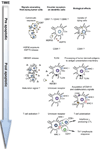Immunogenic and tolerogenic cell death
- PMID: 19365408
- PMCID: PMC2818721
- DOI: 10.1038/nri2545
Immunogenic and tolerogenic cell death
Abstract
The immune system is routinely exposed to dead cells during normal cell turnover, injury and infection. Mechanisms must exist to discriminate between different forms of cell death to correctly eliminate pathogens and promote healing while avoiding responses to self, which can result in autoimmunity. However, an effective immune response against host tissue is often needed to eliminate tumours following treatment with chemotherapeutic agents that trigger tumour cell death. Consequently, a central problem in immunology is to understand how the immune system determines whether cell death is immunogenic, tolerogenic or 'silent'.
Figures



References
-
- Medzhitov R, Janeway CA., Jr. Decoding the patterns of self and nonself by the innate immune system. Science. 2002;296:298–300. - PubMed
-
- Zitvogel L, et al. Immune response against dying tumor cells. Adv Immunol. 2004;84:131–179. - PubMed
-
- Gaipl US, et al. Clearance deficiency and systemic lupus erythematosus (SLE) J Autoimmun. 2007;28:114–121. - PubMed
-
- Matzinger P. The danger model: a renewed sense of self. Science. 2002;296:301–305. - PubMed
-
- Thompson CB. Apoptosis in the pathogenesis and treatment of disease. Science. 1995;267:1456–1462. - PubMed
Publication types
MeSH terms
Substances
Grants and funding
LinkOut - more resources
Full Text Sources
Other Literature Sources

